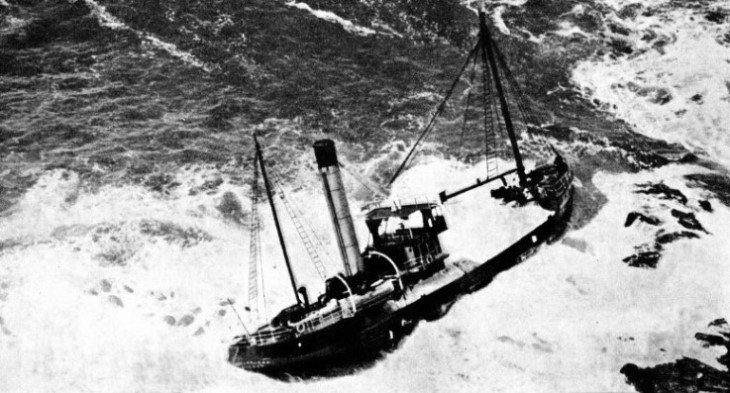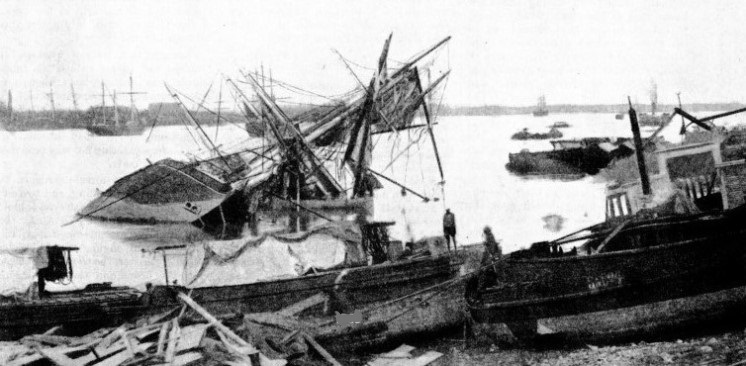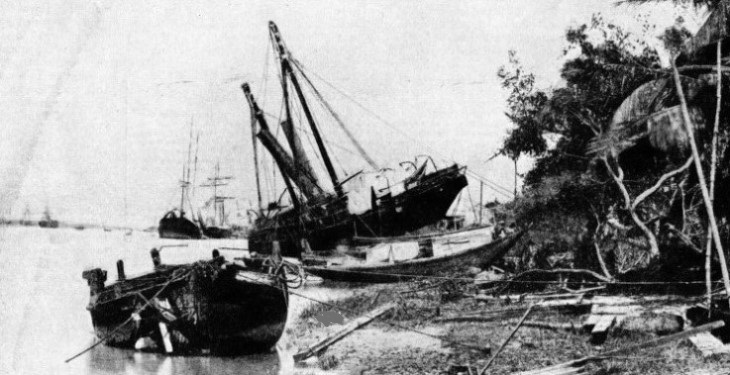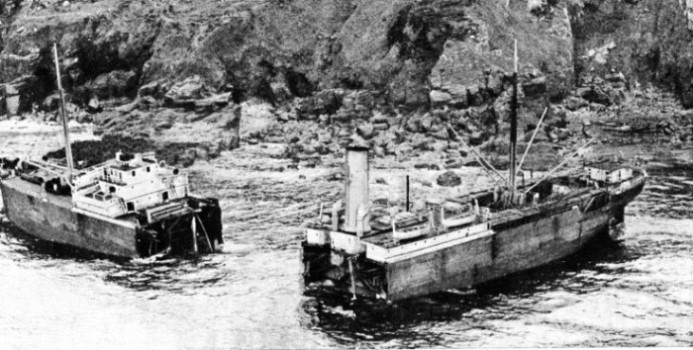

© Shipping Wonders of the World 2012-

Storm and Tempest at Sea
All over the Seven Seas there are regions, well known to seamen, where bad weather may generally be expected, though storms are not confined to these regions. The sailor of to-

WRECKED ON THE COAST OF NEW SOUTH WALES, the Pappinbarra was left at the mercy of heavy seas near Port Stephens. A member of the crew was able to get ashore with a life-
THE sailor no longer regards storms with superstitious awe as the ancients did. He knows that he is better equipped to withstand them than were his predecessors in sail.
The Meteorological Departments of the various maritime nations do work of the utmost value to the sailor. For the purpose of observation the Beaufort Scales give thirteen figures for judging the velocity of the wind and ten for the disturbance of the sea. These scales are used all the world over and is of the greatest service.
The scale ranges from the figure 0 for a calm, when the wind is one mile an hour or less, to 12, which represents a hurricane, anything above sixty-
BEAUFORT WIND SCALE
Beaufort Scale Number : Limits of Velocity (in Knots) : Description
0 : 0-
1 : 1-
2 : 4-
3 : 7-
4 : 11-
5 : 17-
6 : 22-
7 : 28-
8 : 34-
9 : 41-
10 : 48-
11 : 56-
12 : Over 65 : Hurricane
All wind is caused by the rush of air to fill up an area of low pressure. The barometer indicates the existence of an area of low pressure, but to forecast the worst storms something more is needed. Storm charts, therefore, are prepared on a basis of previous experience, and from these the careful captain can get at least a warning of the areas to avoid. In addition, the various meteorological bodies send out warnings based on telegraphic and wireless reports from observers over a large area. Certain ships’ officers take to this voluntary work with great enthusiasm and prove most valuable. By the collation of these reports it is possible to make the reliable prophecy which can be sent out by wireless.
All over the Seven Seas there are regions where bad weather is expected as a rule. Generally these areas are influenced more by the configuration of the land than by the sea. Most prominent capes are the breeding areas of heavy storms, each with its own characteristics. Cape Horn, for instance, is almost synonymous with bad weather and tremendous seas which, although they are big, are of considerable length. Cape Horn, therefore, is scarcely dreaded as much as the Cape of Good Hope, once called the Cape of Storms, where the Agulhas Current, running against the wind, can raise a colossal sea which is particularly dangerous because it is so steep and hollow.
On the North American coast, Cape Hatteras has the reputation of constant bad weather, worst in the hurricane season, and in Australian waters Cape Leeuwin is somewhat similar. The Gulf of Lions, in the Western Mediterranean, and the Bay of Biscay are two other areas in which the wise sailor takes care that everything is secure. On the Great Lakes of America there are often terrible storms, for fresh water rises much more rapidly than salt water in a short, steep sea, which is dangerous to ships.
Great gales in the temperate zones are apt to last longer, and affect a greater area than the violent circular storms of the tropics. Some of these gales have left their mark on history. The Great Gale of 1703 is reputed to be the worst that has ever visited the British Isles. It occurred towards the end of November 1703, and started on a Wednesday. The morning was fine, but at about four o’clock in the afternoon the wind began to rise and all night it increased in strength, a good deal of damage being done to the buildings in London. On Thursday there was a lull, but on Friday the storm got stronger and stronger until on Saturday, November 27, nearly the whole of England was shaken by the terrific hurricane. In the Pool of London, where the shipping of the port was then concentrated to a much greater extent than it is now, only four vessels out of hundreds remained afloat. All down the London River the story was the same, and when it came to reckoning up the damage the greatest impression was made by the comparative safety of the ships in the Howland Great Dock, the first of London’s wet docks and now the Greenland Dock in the Surrey Commercial system.
Among the victims was Henry Winstanley, an ingenious but eccentric mercer who was the first man to have the patriotism to erect a lighthouse on the Eddystone Rocks. That was in 1698. By a strange chance he was in the lighthouse during the Great Gale. After the storm there was not a trace of his work left, and he and all his hands were drowned.
During the second half of the nineteenth century the Atlantic was visited by a number of memorable gales. In August 1873 a great hurricane which affected the larger part of the North Atlantic damaged or wrecked over 1,000 vessels of all kinds, including a number of Grand Banks schooners. In October 1881 a single gale caused well over a hundred wrecks in British waters, and in the Atlantic gale of February 1885 seven well-
Cyclones, Typhoons and Tornadoes
Most dangerous, and probably among the most impressive demonstrations in Nature, are the revolving storms of the tropics, given various names according to their locality. They are generally of limited area, roughly circular, and revolve spirally with the greatest violence round an area of extremely low barometric pressure. The general name for such storms is cyclone, and they are called that in the Indian Ocean. In China, however, they are referred to as typhoons, on the West African coast and in America as tornadoes, and in the West Indies as hurricanes. They are the storms which are dreaded most by every sailor, even in well-
If a ship is caught by such a storm in narrow waters, on a lee shore or even in port, she has less chance of surviving than one caught in the open sea with plenty of room to move. Some of the greatest disasters, involving most loss of life, have been in port, and every well-
In the Indian Ocean a cyclone is a great trouble, particularly at the beginning or end of the monsoons, when it is a contest between the trade wind force and the monsoon force, before either of them obtains a complete ascendancy. February and March are the worst months, but October and November run them close. These cyclones do an immense amount of damage. The neighbourhood of Mauritius is a particularly bad area, but the Bay of Bengal is not much better.
Perhaps the best remembered was the cyclone at Calcutta in October 1864, when an immense amount of damage was done in a short time. The wind was of tremendous strength and in addition the flood tide turned the River Hooghly into a torrent. It was in one of the boom periods of the Indian trade, and the Calcutta Harbour was crowded with shipping. There were about 200 sea-

AFTER THE CYCLONE OF 1864 Calcutta Harbour was a mass of wreckage. Over 200 sea-
The Port of Calcutta had been virtually demolished during those few hours, and at first it appeared hopeless to expect to get any salvage out of the wreck, although a number of ships was afterwards saved. The P. and O. steamers Nubia, Hindostan, Nemesis and Bengal were all driven ashore and damaged, but all were recovered. The American barque North Atlantic, a magnificent vessel which had attracted great admiration the day before the cyclone, had foundered, and across her poop the steamer Thunder was wrecked. On the western bank of the river fine ships were lying in heaps, their bottoms ripped out by being driven over the shore and their sides stove in by collision with equally unfortunate vessels. Three hundred coolies were drowned in the holds of the “country” sailing ship Ally when she capsized.
Large areas of the Pacific are also subject to terrific hurricanes. The Samoan hurricane of 1889, from which H.M.S. Calliope managed to escape, is the one which most often comes to mind. The Calliope was one of the earliest protected cruisers in the Navy and one of the last to be fully rigged. American and German interests were at loggerheads over Samoa and had each sent three men-
Three Ships in Collision
So the cramped, bottle-
Near by the Calliope, Olga and Vandalia were rolling their nettings under in uncomfortable proximity and were repeatedly grinding against one another. Captain Kane, although he had only a single screw ship of poor power, determined that he would try to get out at all costs, although he fully realized the risk that he was running. With the engineers backing him magnificently, he drove her to the limit of her power, but in two hours she had made only half a mile of progress. Ahead of her was the U.S. flagship Trenton, unmanageable, with a smashed rudder, and rolling right in the middle of the fairway with only a few yards between her and the reef.
Through this narrow passage the Calliope had to go. With the mountainous seas throwing her ofi her course every moment she crept forward. The crew of the Trenton knew perfectly well that they were doomed, but, with magnificent spirit, they cheered the little Calliope fighting her way past them against such odds.

WASHED ASHORE BY THE CALCUTTA CYCLONE of 1864, the steamer Thunder was but one of nearly 200 ships that were severely damaged or completely wrecked. This calamity led the Calcutta port authorities to take precautionary measures which are still in force.
Finally, after a terrific struggle, the little ship made her offing, and two days later, when the hurricane had blown itself out, she returned to Apia. The Olga and the Trenton, which had much more powerful engines than she, had met with disaster, the Olga being thrown on to the beach and the Trenton sunk. The Vandalia had also come to grief and of the whole squadron the Calliope was the only ship to survive. Some years before the war of 1914-
The China Seas are famous for their typhoons, also called white squalls. The season is virtually confined to September and October, but trouble is always expected and from time to time typhoons have done enormous damage to the shipping, naval as well as mercantile, in Hong Kong.
Tornadoes are experienced on the West African coast and in America. A tornado, a whirlwind with a straight course, is terribly destructive, although the weather is often quite calm within half a mile on either side of the vortex.
The West Indies and Gulf of Mexico are periodically devastated by hurricanes, whirlwinds moving along a curved track, and August and September are the worst months for these. When the destructive force of the hurricane is assisted by the geographical configuration of the land anything may happen, as the city of Galveston (Texas) has experienced on more than one occasion. The most memorable was on September 8, 1900, when, with little warning, a terrific hurricane carrying with it a tidal wave, burst on the town and its neighbourhood. The entire town, which was built only a few feet above normal sea-
In this hurricane the British steamer Taunton was driven no fewer than thirty miles inland. In another hurricane in the same area in August 1915 the British steamer Wallace finally came to rest a third of a mile from the sea, and the Ribston was not only three-
Tidal waves which do damage of this sort are experienced only close to shore, but the mighty waves of mid-
When the wind which has raised the sea drops, the waves take some time to follow suit, but the top-
The length of a wave — the distance from crest to crest — and its height are difficult to measure and generally give the observer, especially the landsman, a greatly exaggerated idea. Apart from gigantic waves caused by earthquakes, most authorities limit the height of waves to 50 feet, or at the most 70 feet. It is when they meet an obstruction that their real size and power can be appreciated.
The sailor of to-

BROKEN IN TWO ON THE ROCKS on the Cornwall coast, the American ship Bessemer City was wrecked in November 1936. Her crew of 33 was rescued by the St. Ives lifeboat. Built in 1920, the Bessemer City had a gross tonnage of 5,686, a length of 441 ft. 8 in., a beam of 56 feet and a depth of 30 feet. Her radio was put out of action when she struck the rocks, but a local farmer warned the lifeboat station.
You can read more on “The Drama of Life Saving”, “Heroism and Disaster at Sea” and “The Ship That Broke Her Back” on this website.